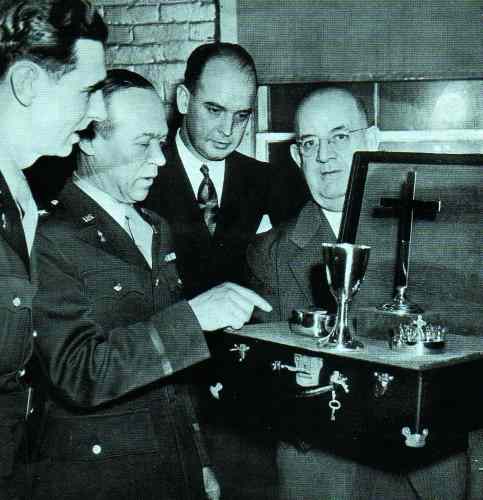
ASSOCIATION OF SMALL COLLECTORS OF ANTIQUE SILVER
ASCAS
| article # 206 |
|
|
|
|
(click on photos to enlarge image)WORLD WAR II CHAPLAINS' KITS
|

|
|
F.P. O'Neill and George Galvin show Capt. Moriarity and Gen. Drewry one of our Chaplain Sets which are supplied to Chaplains all over the world |
The metals used in the kits were a matter of disagreement with government war boards for a while. International normally used a copper alloy as a base metal for ecclesiastical items, then plated them with silver or gold. However, the U.S. government deemed copper critical to the war effort and proposed that International substitute carbon steel as the base. The company obeyed but notified recipients that the altar items wouldnít have an attractive finish - and also might rust.
National church officials energetically protested the governmentís orders to scuttle the copper base--first the Presbyterians, then the Lutherans, then others. Since International already possessed a large amount of the copper alloy needed, and since refining the copper itself out of the alloy would be laborious, the governmentís War Production Board relented. They had received a snowstorm of letters from chaplains about morale and the importance of religious services to the troops.
Plating with Silver and Gold
On the alloy base, International plated most of the field sets with silver. The communion items for the U.S. Catholic Church, though, were plated with 24K gold, and the vessels to contain the bread and wine for mass were made of sterling.
The mark used on the items in the kits is unknown. The company produced many different lines of sterling and silverplate in peacetime, with different marks. International started in 1898 as a partnership of more than a dozen smaller silver companies, and continued to use many of their names and marks. Later the company invented new marketing names for different quality lines, adding to the plethora of marks. A large number of the marks used by the company appear on Giorgio Busettoís website at http://www.silvercollection.it/INTERNATIONALSILVERCO.html .
Earl Chapin Mayís book quotes many grateful clergymen who wrote about their chaplain kits during the war. One chaplain described conducting a service during desert maneuvers; in that situation, sand took the place of water. Somewhere in the Mediterranean, a chaplain used his International kit to set up an altar on the hood of a Jeep. In the South Seas, an American pilot who had just received communion told his chaplain, "You donít know how much this has meant to me." The next day he was killed flying his plane on a rescue mission.
The photo below, from Mayís book, was made in the field and shows a rough wood altar bearing an International cross and candlesticks. The location is unidentified, but it must have been somewhere cold, judging from the heavy jackets. The young men stand solemnly by the burning candles, ready to receive religious succour in a difficult time.
Authorís addendum: A chaplain in the US Army has posted images of World War II chaplain kits online at http://thechaplainkit.com/chaplain-kits/ww2-era/. They include Catholic, Protestant, and Jewish kits in his personal collection. His site does not identify the maker or mark of any of the sets, and the chaplain did not respond to my inquiries.
- 2016 - |
